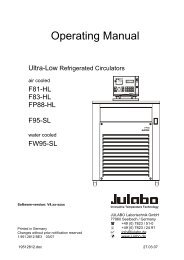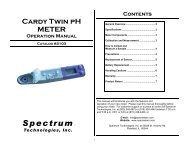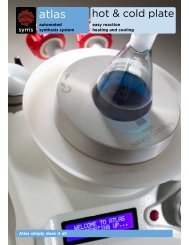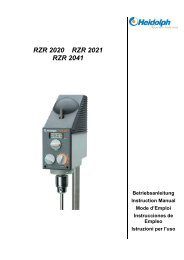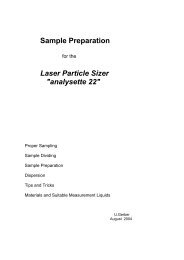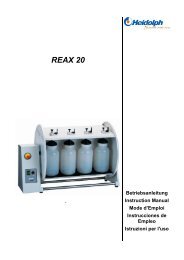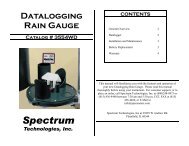Optical Dissolved-Oxygen - Measurement Specialties, Inc.
Optical Dissolved-Oxygen - Measurement Specialties, Inc.
Optical Dissolved-Oxygen - Measurement Specialties, Inc.
You also want an ePaper? Increase the reach of your titles
YUMPU automatically turns print PDFs into web optimized ePapers that Google loves.
Eureka 2 <strong>Optical</strong> <strong>Dissolved</strong>-<strong>Oxygen</strong> Sensor (HDO)<br />
How is DO measured?<br />
There are two types of sensors commonly used to measure DO. The traditional Clark Cell consists of two electrodes<br />
surrounded by a water-based electrolyte solution and covered with an oxygen-permeable membrane. As oxygen crosses<br />
the membrane to dissolve in the electrolyte, it is consumed in a chemical reaction which generates a small electrical<br />
current between the two electrodes. That current is directly proportional to the amount of oxygen in the water sample.<br />
This method is further described in Standard Methods 4500-O G.<br />
Eureka’s Clark Cell DO Sensor<br />
A weakness of the Clark Cell is that it consumes oxygen from the water surrounding the sensor; this means that the water<br />
must be replaced either by natural flow or the use of a circulator to prevent the readings from drifting downward. The<br />
Clark Cell has performed will in the field for decades, but is slowly being replaced by optical DO sensors. The latter have<br />
little calibration drift in the field, are not flow-sensitive (no circulator needed), and do not require the occasional membrane<br />
changes that annoy Clark Cell users.<br />
Clark<br />
Cell’s<br />
circulator<br />
Clark Cell<br />
DO sensor<br />
The second type of DO sensor is the optical DO sensor, in which a blue light is directed to an oxygen-active compound<br />
that has been stabilized in an oxygen-permeable polymer. The blue light causes the oxygen-active compound to<br />
fluoresce – i.e. it absorbs energy in the form of blue light and then emits energy as red light. The fluorescence is<br />
quenched by oxygen – that is, the emission of red light is reduced if oxygen molecules are present to interfere with the<br />
oxygen-active compound. The more oxygen present, the smaller the amount of red light produced.<br />
When the polymer sensing surface is exposed to water, oxygen diffuses into the sensing surface according to the amount<br />
(“partial pressure”) of oxygen in the water. Thus, the amount of red light received by the sensor is directly relatable to the<br />
amount of oxygen in the water. The red light signal is calibrated to the proper DO units.<br />
Despite its considerably higher cost, the optical sensor is often favored over the Clark Cell because the optical sensors<br />
have little calibration drift in the field, are not flow-sensitive (no circulator needed), and do not require the occasional<br />
membrane changes that annoy Clark sensor users.<br />
Eureka 2 HDO Sensor www.meas-spec.com September 2012<br />
2113 Wells Branch, Suite 4400, Austin TX 78728 512-302-4333 WQ.sales@meas-spec.com






